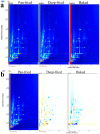Effect of Different Heat Treatments on the Quality and Flavor Compounds of Black Tibetan Sheep Meat by HS-GC-IMS Coupled with Multivariate Analysis
- PMID: 36615360
- PMCID: PMC9822090
- DOI: 10.3390/molecules28010165
Effect of Different Heat Treatments on the Quality and Flavor Compounds of Black Tibetan Sheep Meat by HS-GC-IMS Coupled with Multivariate Analysis
Abstract
There are limited reports about the effect of different heat treatments on the quality and flavor of Black Tibetan sheep meat. The current study examined the effect of pan-frying, deep-frying, baking, and boiling treatment on the quality of Black Tibetan sheep meat; the amino acid, fatty acid, and volatile flavor compounds (VFCs) were investigated by a texture analyzer, ultra-high-performance liquid chromatography (UHPLC), gas chromatography (GC), and headspace-gas chromatography-ion mobility (HS-GC-IMS). The key VFCs were identified through orthogonal partial least squares discrimination analysis (OPLS-DA), and variable importance projection (VIP) values. In addition, Pearson’s correlations between meat quality parameters and key VFCs were examined. The sensory scores, including texture, color, and appearance, of baked and pan-fried meat were higher than those of deep-fried and boiled meat. The protein (40.47%) and amino acid (62.93 µmol/g) contents were the highest in pan-fried meat (p < 0.05). Additionally, it contained the highest amounts of monounsaturated and polyunsaturated fatty acids, such as oleic, linoleic, and α-linolenic acids (p < 0.05). Meanwhile, pan-fried and deep-fried meat had higher amounts of VFCs than baked meat. The OPLS-DA similarity and fingerprinting analyses revealed significant differences between the three heat treatment methods. Aldehydes were the key aroma compounds in pan-fried meat. Importantly, 3-methylbutyraldehyde and 2-heptanone contents were positively correlated with eicosenoic, oleic, isooleic, linoleic, α-Linolenic, and eicosadiene acids (p < 0.05). To sum up, pan-fried Black Tibetan sheep meat had the best edible, nutritional, and flavor quality.
Keywords: black Tibetan sheep; heat treatment; meat flavor; pan-fried meat quality.
Conflict of interest statement
The authors declare no conflict of interest.
Figures









Similar articles
-
Identification of volatile flavor substances in four key muscle portions of five Tibetan sheep breeds.J Sci Food Agric. 2025 Aug 30;105(11):5950-5961. doi: 10.1002/jsfa.14319. Epub 2025 May 1. J Sci Food Agric. 2025. PMID: 40312977
-
Characterization of Flavor Compounds in Chinese Indigenous Sheep Breeds Using Gas Chromatography-Ion Mobility Spectrometry and Chemometrics.Foods. 2024 Aug 23;13(17):2647. doi: 10.3390/foods13172647. Foods. 2024. PMID: 39272414 Free PMC article.
-
Characterization of Key Compounds of Organic Acids and Aroma Volatiles in Fruits of Different Actinidia argute Resources Based on High-Performance Liquid Chromatography (HPLC) and Headspace Gas Chromatography-Ion Mobility Spectrometry (HS-GC-IMS).Foods. 2023 Sep 28;12(19):3615. doi: 10.3390/foods12193615. Foods. 2023. PMID: 37835267 Free PMC article.
-
Deep-fried flavor: characteristics, formation mechanisms, and influencing factors.Crit Rev Food Sci Nutr. 2020;60(9):1496-1514. doi: 10.1080/10408398.2019.1575792. Epub 2019 Feb 11. Crit Rev Food Sci Nutr. 2020. PMID: 30740987 Review.
-
Recent progress in food flavor analysis using gas chromatography-ion mobility spectrometry (GC-IMS).Food Chem. 2020 Jun 15;315:126158. doi: 10.1016/j.foodchem.2019.126158. Epub 2020 Jan 7. Food Chem. 2020. PMID: 32014672 Review.
Cited by
-
Effects of yeast cultures on meat quality, flavor composition and rumen microbiota in lambs.Curr Res Food Sci. 2024 Sep 11;9:100845. doi: 10.1016/j.crfs.2024.100845. eCollection 2024. Curr Res Food Sci. 2024. PMID: 39376582 Free PMC article.
-
Volatile Compounds and Fatty Acids of Mutton Carrot Filling During Dynamic Steaming Investigated Based on GC-MS and GC-IMS Analyses.Foods. 2025 Apr 27;14(9):1535. doi: 10.3390/foods14091535. Foods. 2025. PMID: 40361619 Free PMC article.
-
Effects of intramuscular fat on the flavor of fresh sheep and goat meat: Recent insights into pre-mortem and post-mortem factors.Food Chem X. 2025 Jan 4;25:102159. doi: 10.1016/j.fochx.2025.102159. eCollection 2025 Jan. Food Chem X. 2025. PMID: 39867221 Free PMC article. Review.
-
Quality Characteristics and Volatile Components of Chili Oil Prepared from the Combination of Shuanla and Erjingtiao Peppers.Molecules. 2024 Dec 6;29(23):5767. doi: 10.3390/molecules29235767. Molecules. 2024. PMID: 39683924 Free PMC article.
-
Effects of Heating Treatment on the Physicochemical and Volatile Flavor Properties of Argentinian Shortfin Squid (Illex argentinus).Foods. 2024 Mar 27;13(7):1025. doi: 10.3390/foods13071025. Foods. 2024. PMID: 38611331 Free PMC article.
References
-
- ScienceDirect Altered Milk Yield and Rumen Microbial Abundance in Response to Concentrate Supplementation during the Cold Season in Tibetan Sheep. [(accessed on 30 November 2022)]. Available online: http://www-sciencedirect-com-443.bjmu.ilibs.cn/science/article/pii/S0717....
-
- Zhang X., Han L., Hou S., Raza S.H.A., Gui L., Sun S., Wang Z., Yang B., Yuan Z., Simal-Gandara J., et al. Metabolomics Approach Reveals High Energy Diet Improves the Quality and Enhances the Flavor of Black Tibetan Sheep Meat by Altering the Composition of Rumen Microbiota. Front. Nutr. 2022;9:915558. doi: 10.3389/fnut.2022.915558. - DOI - PMC - PubMed
-
- Ma B., Zhang C., Raza S.H.A., Yang B., Aloufi B.H., Alshammari A.M., AlGabbani Q., Khan R., Hou S., Gui L. Effects of Dietary Non-Fibrous Carbohydrate (NFC) to Neutral Detergent Fiber (NDF) Ratio Change on Rumen Bacterial Community and Ruminal Fermentation Parameters in Chinese Black Tibetan Sheep (Ovis aries) Small Rumin. Res. 2022;216:106793. doi: 10.1016/j.smallrumres.2022.106793. - DOI
-
- Oz F., Aksu M.I., Turan M. The Effects of Different Cooking Methods on Some Quality Criteria and Mineral Composition of Beef Steaks. J. Food Process. Preserv. 2017;41:e13008. doi: 10.1111/jfpp.13008. - DOI
MeSH terms
Substances
Grants and funding
LinkOut - more resources
Full Text Sources
Miscellaneous

